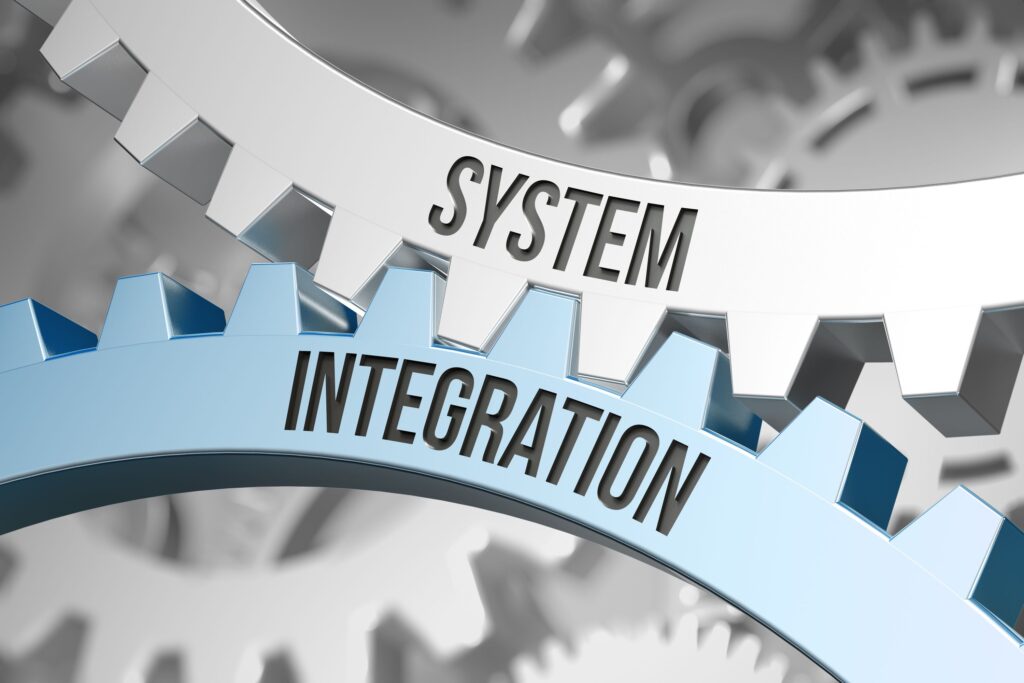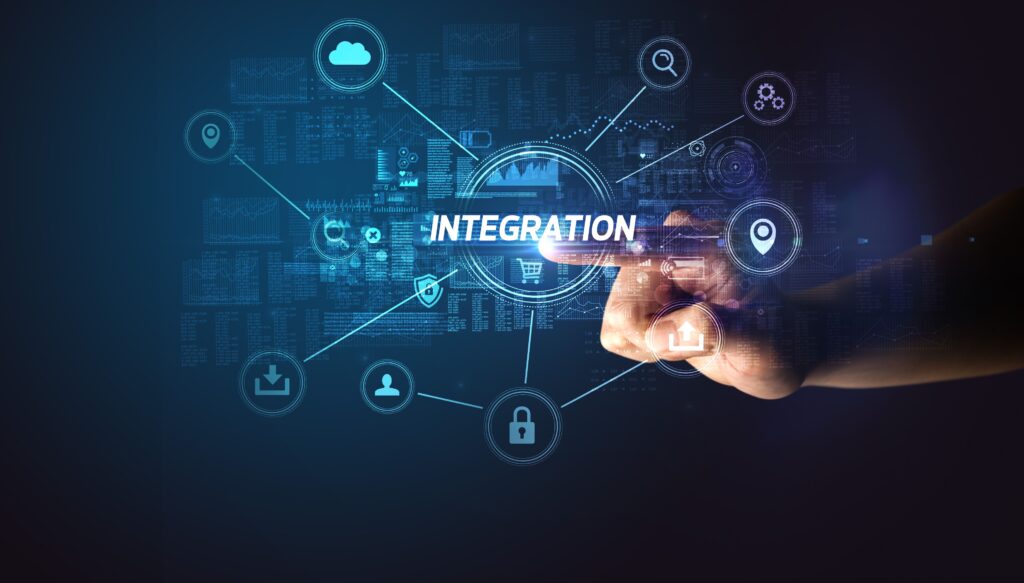What Is System Integration
Combining all of an organization’s physical and virtual components is system integration. Machine systems, computer hardware, inventories, and other elements are the physical components. Data stored in databases, software, and apps make up the virtual components. The primary emphasis of system integration is integrating all of these components to operate as a single system.
System integration is critical for both business-to-business communication and internal corporate collaboration. It is what we should perform regularly.

What Is System Integration
In its broadest sense, system integration is the act of linking several subsystems into a single, more extensive system that works as a whole. When it comes to software, system integration connects disparate IT services, methods, and software to make them all operate together functionally.
The primary motivation for businesses to adopt system integration is to increase efficiency and quality improvement of their operations. The idea is to use integration to make the organization’s multiple IT systems “speak to each other,” speeding up information flows and lowering operating expenses. However, system integration isn’t just for connecting an organization’s internal systems; it also secures its external partners.
Types of System Integration
There are various types of system integration, and the size and scope of integration projects range from simple to massive and complex. Here are some examples:
Business-to-Business Integration
This type of integration enables businesses to easily exchange data and knowledge, for example, across a supply chain, reducing redundancy.
Legacy System Integration
Legacy system integration enables organizations to connect legacy systems with newer, more modern designs.
Big Data Integration
Integrating data origination from disparate business systems, various sources, and different formats is critical in any big-data project. It enables the collection of all data into a single view for reporting and analysis.
Third-party System Integration
In many cases, developing custom software is not feasible. Third-party software products, which need to integrate with other systems and applications already in the organization, may be used instead.
Cloud Services Integration
It is the process of connecting various applications, systems, and databases to be integrated into cloud services, allowing multiple devices to access them over a network or the internet.
Advantages of System Integration
System integration is a critical component in digital organizational transformation. Among the advantages are:
Enhanced Productivity
Without adequate integration, it forces the workers to manually enter data into numerous programs rather than provide value to the process. Data is exchanged automatically between systems through system integration, resulting in smoother workflows, improved process efficiency, and lower error margins.
Improved Decision-making
Another benefit of centralizing data in one platform or system is using real-time, accurate data beyond conventional organizational boundaries, enabling a 360° perspective of a business. Organizations can develop and save expenses by making better, more accurate judgments.
Alternative to Replacing Legacy Systems
Some businesses may rely on systems far past their end-of-life yet remain irreplaceable. Integrating data from historical systems into newer methods enables companies to continue working with existing designs while advancing digital transformation.
Capability to Monitor Company Performance
Organizations cannot analyze data since data is housed in disparate systems and applications, resulting in data silos. Gathering all data in a centralized system enhances data analysis, ensures consistency, and raises the data’s value.
Disadvantages of System Integration
Although system integration is a fantastic solution for several challenges associated with employing multiple applications, it does have a few drawbacks.
Complicated Updating
Your IT team will likely make some extreme memories regarding system overhaul. Integration does not combine many projects into one but instead integrates them. The interaction is erratic and tiresome.
Significant Financial Outlay
Even if you can obtain a fantastic price on system support, you must pay for each software separately. Occasionally, prices are so exorbitant that an entrepreneur may begin to consider bespoke software development rather than system integration.
Concerns About Security
Having several projects is preferable to a single integrated system in terms of security. When you go through system integration, any misrepresentation or even hack might acquire access to complete your information rather than just a portion of it.
Because of the pathways via which information flows from one application to the next, system integration renders your data more vulnerable than it was previously.

Methods of System Integration
The following are the main categories of typical system integration methods:
Vertical Integration
The system components are merged using the vertical integration approach by constructing functional “silos” that start at the bottom and way up. It is a comparatively straightforward way that only needs a small number of systems, fewer than two. However, it is also highly inflexible and more challenging to maintain in the long run because any new functionality will require its own functional “silo.” Even yet, this strategy works well for creating basic integrations that need to address a single function.
Star Integration
A system with star integration is one in which each subsystem links to other subsystems via point-to-point links. It provides additional capability, but as the number of connected systems grows, so does the number of integrations, and integration management becomes extremely difficult. As an analogy to “Spaghetti coding,” Star Integration is often referred to as “Spaghetti Integration.”
Point to Point Integration
Because only two system components are involved, one may argue that a point-to-point integration or point-to-point link is not a simple system integration. Even though it lacks the intricacy of “real” system integration, it integrates two systems to work together. Typically, this type of point-to-point integration handles one function without complicated business logic. These sorts of point-to-point connections are available as productized, “out of the box” integration modules for the most common IT systems in many cloud-based apps.
Common Data Format Integration
Integration of disparate IT systems frequently necessitates transforming data from one system to a different data format required by the receiving system. If each transformation must be performed on a system-by-system basis, the number of data transformations skyrockets and becomes a high-maintenance operation. The standard data format strategy allows each system to do only one data conversion to address the issue. As a result, the number of needed data transformations is only as large as the number of subsystems.
Horizontal Integration
There is an employed distinct subsystem as a standard interface layer between all subsystems in horizontal integration. This layer refers to as an Enterprise Service Bus (ESB). This technology enables each subsystem to communicate with all other subsystems attached to the standard interface layer via a single interface. This strategy has the advantage of allowing any subsystem to be updated. Also, even replaced without redo the interfaces of any other methods.
Challenges of System Integration
There is no system integration rocket science, but several obstacles make it difficult for all firms to implement. According to some research, up to 70% of all integration attempts fail in one way or another. It is more likely to happen with big projects, but even relatively simple system integration initiatives might have issues.
The majority cause of failures is project and change management challenges. It is not by the selected integration technology or technical difficulties with the systems in the scope.
The following are the most common causes for system integration project failure:
Scarcity of Skilled Resources
System integration needs specialized knowledge that is difficult to acquire by. It is not enough to have outstanding integration technology if the necessary expertise is unavailable. Most businesses struggle to locate and keep individuals with the required system integration capabilities.
The easiest way to address the issue is to work with an external third-party supplier who can bring the necessary integration experience to the table and supply the integration technology.
Changes in the Integration Landscape Constantly
The more time the project takes, the more serious this problem gets. Time is the key in managing this risk; keeping integration initiatives brief increases the project’s success percentage. Furthermore, the success of the systems integration depends on an agile working approach that can adapt to change both during and after the project.
Lack of Responsibility
When integrating many distinct subsystems, it is easy to lose track of who is responsible for the integration’s success. Several stakeholders (e.g., system owners, suppliers, etc.) may be in the equation, none of whom is in charge of the complete system integration. They care about and handle their side of integration to the best of their abilities, but they will not travel beyond their zone.
However, there is usually more than one person involved in integration. As a result, when something goes wrong, the scenario quickly devolves into finger-pointing and blaming the other parties rather than someone “owning” the integration. Suppose a single party manages the system integration project. That party is also (typically contractually) accountable for the project’s success, and there is no doubt about accountability.
What Is the Role of a System Integrator
A Systems Integrator (SI) is a firm that specializes in implementing, organizing, planning, scheduling, testing, enhancing, and occasionally managing IT systems in broad terms in the IT sector. They deliver massive IT projects (e.g., ERP projects) while addressing the multiple vendors involved.
In terms of system integration, however, the responsibility of the systems integrator is limited to facilitating data integrations between the end customer’s various current systems as described in the project scope. It can range from essential internal point-to-point connections to extremely complicated many-to-many integrations with internal and external parties.
In this equation, the systems integrator’s function is typically to design, develop, and test the integration solution. However, the systems integrator’s responsibility may also involve continual management of the keys and contacting other parties to enable connections with them. Most significantly, the systems integrator brings integration knowledge to the table that the customer would otherwise lack internally (or has a shortage of available internal resources at hand).

Why Is Business-to-Business Integration More Important Than Ever
Business-to-business integration is not a new notion by any means. Nearly 50 years ago, several IT-driven firms began executing B2B Integration projects. Perhaps, by now, some of them have even completed these projects.
B2B integration is the process of integrating, automating, and optimizing business operations that exist outside of a company’s firewall. While these processes may differ significantly, they all have one thing in common: integrating such external business processes provides the firm with a long-term competitive edge. Real-time visibility, enhanced automation, inventory optimization, and improved customer satisfaction are examples of such benefits.
Businesses now realize that having robust software solutions is insufficient. They may have the most feature-rich software applications behind their firewall or in the cloud, but they cannot successfully manage their end-to-end supply chain process without suitable B2B connection and accompanying capabilities.
While B2B Integration originated with major organizations demanding ways to receive business information, it swiftly adopted EDI (Electronic Data Interchange) standards and then to other newer technologies. Nowadays, it appears that every new program includes an API that allows it to integrate with other applications. However, integrating such APIs with other systems remains, and most businesses do not know.
Integration of the Legacy System
For decades, most operating businesses have some old, legacy IT systems still in use and running on their on-premise servers. These systems may be critical to their core operation and cannot replace a more current IT system. Integration with such vintage systems may be complex since they may be devoid of ready-made interface capabilities.
Most systems, however, may write or read information into a file folder that another system can access. For example, via an FTP connection, but sometimes the only option to integrate such subsystems with other subsystems is to write and read data directly in their database.
A contemporary integration solution must also be capable of dealing with these types of integration scenarios. Cloud-based iPaaS solutions often rely on local, on-premise adapters to deliver the functionality required for these interfaces. Such adapters serve as an active local interface between the passive legacy system or its database and the iPaaS solution hosted in the cloud.
As needed, additional business rules and other functionality related to legacy system integration will be handled in the iPaaS service, keeping such business logic centralized and straightforward to maintain. As a result, the customer doesn’t have to make any costly changes to its old IT systems. The system integrator may supply the integration logic outside of the business firewall.
Why Should Systems Be Integrated
When a company expands, they add new processes, or existing ones may become more complex. The IT landscape may struggle to keep up with the organization and its growing workforce. Different business functions may eventually work in separate systems that do not communicate or share data. As a result, processes become inefficient and costly.
Instead, integrating the business processes on a single platform can bring together functions along the business process chain. Because of the improved flow of information, this will improve productivity and operational quality. However, system integration can be complex.
Failed integration initiatives can have far-reaching effects, even leading to mergers faltering over IT system integration. The most typical integration difficulty involves two or more parties collaborating. It may result in hesitant data sharing and operations outsourcing, a lack of clear communication, confusing duties, debates over where functionality locates, and a lack of responsibility. Other difficulties include:
- Transformations in the integration landscape.
- Integration difficulties centered on API.
- Integration may be expensive, especially in large projects.
- Identifying people capable of handling the integration project.
System Integration with SIS
Starting with the correct business software and systems is critical to make integration as simple as feasible. However, in addition to other criteria, selecting the right integration platform for your integration project might affect how likely you succeed. Get in touch with Southwest Integrated Solutions now!

